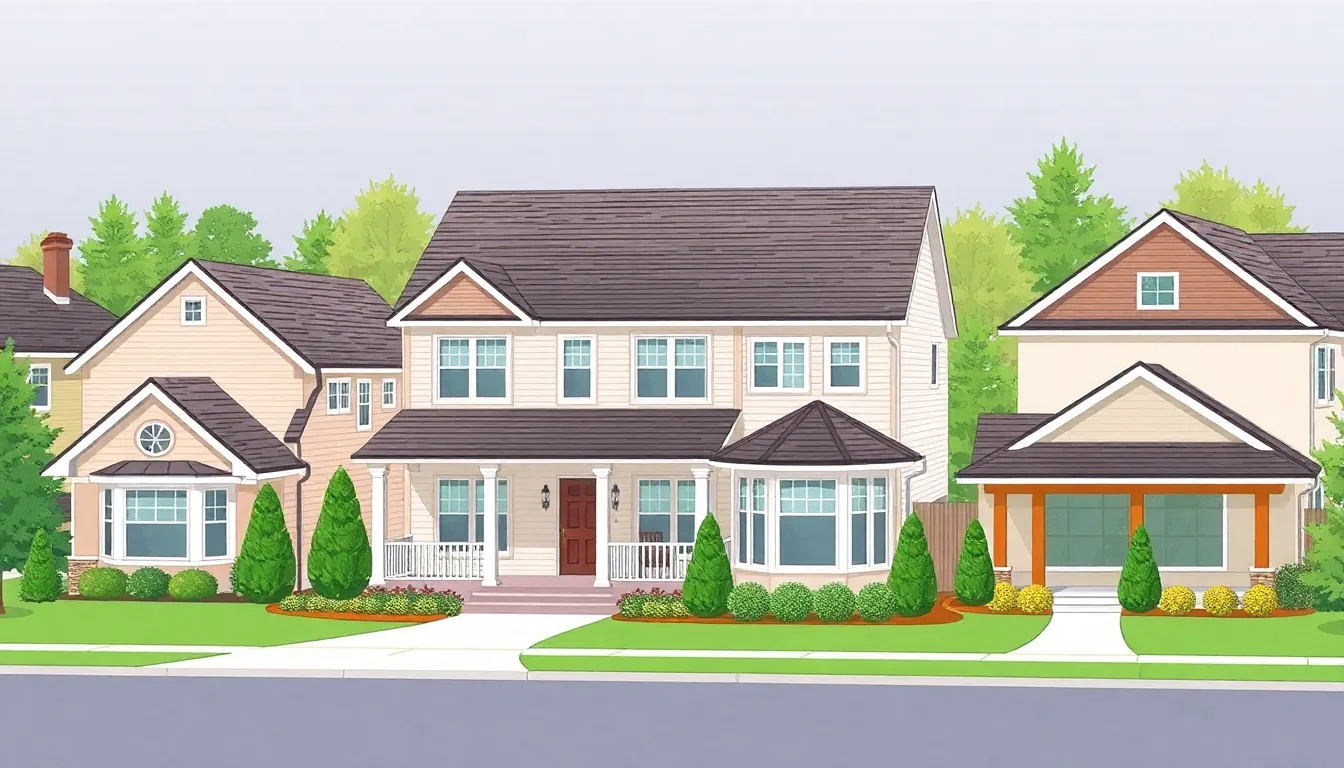Table of Contents
ToggleWhen it comes to designing a home, the roof often plays second fiddle to flashy interiors and trendy decor. But let’s face it: a roof is like a hat for your house. Choose the wrong one, and you might as well be wearing a sombrero to a black-tie event. From sleek modern designs to charming rustic styles, the types of roofs available can dramatically change a home’s personality—and its curb appeal.
Types of Roofs for Houses
Roofs contribute significantly to a home’s character and aesthetic appeal. Various styles exist, each offering unique benefits and visual impressions.
Gable Roofs
Gable roofs feature two sloped sides that meet at a central ridge, creating a triangular shape. This design allows for efficient water drainage, reducing the risk of leaks and damage. Gable roofs are popular in various architectural styles, including Colonial and contemporary homes. They provide additional attic space and improved ventilation. Installation costs are often lower, making them an attractive choice for homeowners.
Hip Roofs
Hip roofs consist of four sloping sides that meet at a top ridge, forming a pyramid-like shape. This design is more stable than gable roofs, making it suitable for areas prone to high winds. Hip roofs can be enhanced with overhangs, providing extra shade and protection from the elements. They offer more interior space compared to gable roofs by accommodating additional rooms. Various materials, including shingles and metal, complement hip roofs, enhancing their curb appeal.
Flat Roofs
Flat roofs present a minimalistic design that aligns well with modern architectural styles. Although they lack the pitch of traditional roofs, they allow for the use of rooftop gardens and living spaces. Proper drainage systems are essential to prevent water accumulation. This style facilitates easy installation of solar panels, appealing to energy-conscious homeowners. Maintenance can be more frequent due to potential leaks, but the unique aesthetic is often worth the effort.
Shed Roofs
Shed roofs feature a single sloping plane, creating a contemporary look that’s widely used in minimalist designs. This style allows for high ceilings and ample natural light through tall windows. Shed roofs are often favored in areas with heavy snowfall, as snow slides off easily. Their simple structure makes construction relatively straightforward and cost-effective. Versatility in design options enables homeowners to experiment with different materials and colors.
Benefits of Different Roof Types

Selecting the right roof type offers numerous advantages that enhance both functionality and appearance. The design of a roof can impact aspects such as energy efficiency, maintenance, and even resale value.
Aesthetic Appeal
Gable roofs create a classic look that adds charm to a home. Hip roofs contribute an elegant profile, often giving a more sophisticated appearance. Flat roofs provide a sleek, modern aesthetic, suitable for urban environments. Shed roofs, with their unique angles, lend a contemporary touch that stands out in suburban neighborhoods. Each style influences the overall architectural design and complements landscaping choices, enabling homeowners to express their personal taste while enhancing curb appeal.
Energy Efficiency
Gable roofs facilitate efficient airflow, which helps regulate indoor temperatures during summer months. Hip roofs also promote better airflow due to their sloping design, reducing heating and cooling costs. Flat roofs can accommodate reflective materials that minimize heat absorption, leading to lower energy expenses. Shed roofs often allow for the installation of solar panels, maximizing homeowners’ renewable energy potential. Overall, the right roof type contributes significantly to energy conservation, benefiting both the environment and household budgets.
Popular Roof Materials
Different roof materials significantly influence the home’s durability and aesthetic. Several options stand out in the market, each with its own set of benefits.
Asphalt Shingles
Asphalt shingles remain one of the most common roofing materials due to their affordability and ease of installation. They come in various colors, providing versatility in design to suit different architectural styles. Longevity spans 15 to 30 years, with proper maintenance extending their lifespan. Homeowners appreciate their impact-resistant properties, which can withstand harsh weather. Additionally, asphalt shingles offer good energy efficiency when combined with reflective coatings.
Metal Roofing
Metal roofing presents a highly durable alternative, often lasting 40 to 70 years with minimal upkeep. This material is available in various styles, including standing seam and corrugated, meeting both traditional and modern design preferences. Lightweight yet strong, metal roofs are energy efficient, reflecting solar heat and reducing energy costs. Their resistance to extreme weather makes them an excellent choice for those in storm-prone regions. Furthermore, metal roofing is environmentally friendly, as many products contain recycled materials.
Tile Roofing
Tile roofing exudes elegance and longevity, often surpassing 50 years with proper care. Commonly made from clay or concrete, tiles offer excellent insulation and are fire-resistant. Their ability to withstand harsh climates makes them a popular choice for Mediterranean and Spanish-style homes. Diverse colors and designs enhance curb appeal, appealing to those seeking a distinctive look. Although initial installation costs can be high, their durability and low maintenance needs result in long-term savings.
Tips for Choosing the Right Roof
Choosing the right roof involves careful consideration of several factors. Prioritizing needs and circumstances can help ensure a suitable selection.
Consider Your Climate
Climate significantly influences roof performance. Heavier snowfall regions benefit from steep gable or shed roofs, which facilitate snow runoff. In humid climates, opting for metal or tile roofs helps prevent mold and moisture accumulation. Windy areas require durable designs like hip roofs for better stability against gusts. Understanding local conditions informs material choice, ensuring a roof can withstand environmental challenges.
Evaluate Your Budget
Budget constraints shape roof choices. Asphalt shingles provide an affordable solution, typically costing between $90 to $100 per square. Metal roofing, while more expensive at $120 to $900 per square, lasts longer, presenting value over time. Tile roofs, ranging from $300 to $1,500 per square, offer durability and elegance but may stretch budgets. Assessing costs alongside long-term benefits enables informed decisions that align with financial resources.
Choosing the right roof type is crucial for enhancing a home’s aesthetic and functionality. Each style offers distinct advantages that cater to different needs and preferences. Whether a homeowner leans towards the charm of gable roofs or the sleekness of flat roofs, the decision can significantly influence both energy efficiency and curb appeal.
Investing time in understanding roof materials and designs ensures that the chosen option aligns with the home’s character and the homeowner’s budget. By making informed choices, they can enhance their home’s beauty while also improving its longevity and performance. A well-selected roof not only protects but also elevates the entire living experience.





